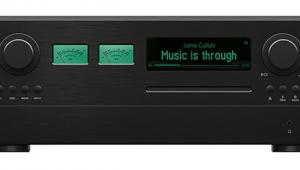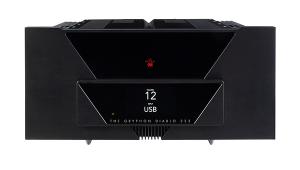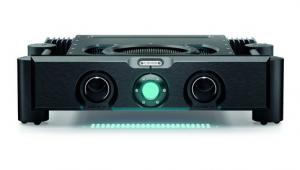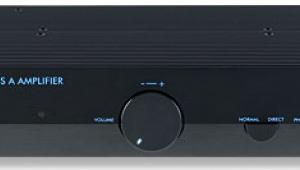Perreaux Audiant 80i (£2299)

In its 37 years as an amplifier manufacturer, Perreaux has gone from its 22W/ch GS 2002 integrated debut product to eye-watering 750W monoblock powerhouses. Separate preamps, professional gear, D/A converters, CD players – it’s a full-line brand that’s maintained a global reputation despite the remoteness of a manufacturing base in New Zealand.
Along the way, Perreaux was bitten by the MOSFET bug. Having decided not to go with valves as far back as 1974, due to the inconveniences of size, weight and heat, and not entirely happy with the sound of bipolar solid-state devices, MOSFETs seemed a godsend. Ironically, the weight issue they associated with valves seems to have been forgotten, as Perreaux kit is hardly svelte. One must sympathise with the pain of shipping costs from New Zealand, which must have been a consideration back then for a fledgling brand, but that 750W amp weighs 31kg!
A NEW LOOK
But back to MOSFETs. As with others who discovered the devices, Perreaux’s designers appreciated their sonic similarities to valves, and have been happy enough to maintain them as the company’s active device of choice ever since the release of its first MOSFET amplifiers, the 80W/ch SA80B integrated and the 200W/ch PMF2000 stereo power amplifier, the latter designed for both domestic and professional applications.
Perreaux is not new to entry or mid-level gear, having launched the affordable EP preamplifier and E1 and E2 power amplifiers in 1987. At £2299, the Audiant 80i integrated, unveiled at THE SHOW in Las Vegas this past January, is a descendent of sorts, but it is most notable for introducing a new look. When I hear the name Perreaux, I think of super-clean styling, like the latest upper-level products from Arcam or even Copland. With the Audiant 80i, Perreaux leaves the anodyne for the avant-garde.
Perreaux rates its Audiant 80i at 80W/ch with 8ohm loudspeakers or 130W/ch with 4ohm in Class AB mode [see Lab Report]. Fine by me: I did all of the serious listening through the Wilson Audio Sophia 3s, which are rated at 4ohm with a 3.1ohm minimum. The Audiant 80i positively partied with the Sophias. Solid, loud, extended, with no hint of stress – it’s a testament to the beefy power supply, the heart of which is a hefty, custom-designed 400VA toroid power transformer.
For many, it’s enough that this integrated amplifier delivers reasonable power, bears a nice MM-only phono stage and has a remote control. But Perreaux has upped the ante with the inclusion of an upsampling 24-bit/96kHz DAC. This, depending on the way you might break down the cost of the DAC versus the amplifier itself, could be either a freebie or a £1900 amp with a £400 DAC, a £2000 amp with a £300 DAC and so on. Suffice it to say, it will accept all manner of digital products via optical and coaxial digital inputs, but of prime interest in 2011 and beyond, the inclusion of a USB input makes this very much a contemporary ‘home music control centre’.
Perreaux even provides the correct USB cable, so you can hook up any computer and use whatever is your preferred front end, such as iTunes or WinAmp, to control the music that resides in your PC/Mac. This unit certainly spans the eras and formats, the above computer-based cohabitation nestling side-by-side with phono stage and a selectable home theatre input for integration into cinema systems. There’s a tape loop as well, which can be used either for your recorder of choice, or for some form of external processor.
Operating the 80i is a joy, and not just because of the full-function IR remote control that will even run the basic commands for iTunes and Windows Media Player. It also dims the LED backlighting on the fascia and operates every other function. But that won’t stop you from occasionally choosing sources or selecting stand-by with your finger on the front panel: the soft-touch controls are slick and positive, despite no moving parts. It is this row of soft-touch command points, in their own gloss-black lower-half of the faceplate, that creates the new look for Perreaux.
CURATE'S EGG?
Making no allowances for price, I used the Perreaux with the Wilsons and the Musical Fidelity kW25 transport and DAC; the Marantz CD12/DA12 transport and DAC; an all-Linn LP12 front-end with Ekos and Arkiv; my netbook computer running WinAmp Pro; and cables from Kimber and YTER. Set-up was intuitive, the unit’s behaviour proving impeccable.
This is, however, an amplifier of ‘three parts’ rather than one, about which you might generalise. I felt compelled to listen to it 1) for its line inputs, 2) for the phono stage and 3) for the DAC, each of which had its own character. I would dismiss the DAC first, because it bettered neither the Musical Fidelity nor the Marantz, and I would consider it solely a handy-to-have feature. Downloads sounded pleasant enough, but some high-res material I fed it, including the remastered Beatles catalogue supplied as an Apple-shaped USB stick, lacked a bit of sparkle and punch. This is not to say it’s awful nor even substandard, and it certainly doesn’t undermine the worth of the 80i. It’s just that there are stupefyingly amazing stand-alone DACs out there for under £500, so this is merely a sideshow. A big ‘however’, though, is the undeniable convenience, especially if you’re toying with a feed from your computer to your sound system but aren’t expecting a life-changing experience.
Next up, the phono stage. Its gain is impressive, allowing me to use the Linn MC without the loss of much headroom, though it clearly favoured an MM from Ortofon. Listening to ‘Pride Of Man’ from the first Quicksilver Messenger Service LP, I was charmed by the authentic guitar sound and rich lower registers. The textures of Nick Lowe’s voice on Labour of Lust, too, had a realism that sent me back to an occasion when I heard him playing unplugged at Ronnie Scott’s a few decades ago. And when a hi-fi system does that, I will forgive it anything.
If I seem dismissive, though, of both the digital stage and the phono section, it’s only because the Audiant 80i truly shows its worth when fed from superior sources. Using the two CD players with their DACs, the Perreaux revealed all manner of desirable traits, not least being impressive punch, bass extension and airiness.
Although I’m not feeling particularly nostalgic of late, despite the above brief foray back to Soho, I was drawn to Human League’s audiophilic milestone, the dance mix of ‘Don’t You Want Me’, replete with woofer-busting bass. My 12in vinyl copy only comes out on high days and holidays, but the mix ended up on a superb reissue in 2002. I had forgotten the impact of the entire seven-minute-plus track, especially the drums’n’bass crunch at the 4m 30s mark… It tested the Perreaux and the Perreaux simply delivered. No nasty crunching sounds of the sort that are only desirable when one’s teeth enter a crispy duck roll at Yauatcha. No thuds, no gaseous exhausts, no lumpy decay from the percussion, nor growling from the massed synths. Every note came though loud and clear, with heart-stopping breaks at 2m 25s so clean and tight that I wanted to play it through a single-ended triode just to hear the flab I have always suspected with them.
SHIMMERING LAYLA
The Sophias are so breathtakingly kind and forgiving that it’s hard to reconcile their sweetness with the way that they are also relentlessly revealing. I am too weak and failed a philosopher to even attempt figuring out how such schizophrenia can exist in the same entity, yet that is their magic. Every time I realise that it’s helping the components that precede it in the musical chain, I wonder if perhaps I need to change to a more remorseless transducer. The 80i was sounding, well, wonderful.
Then again, the dance mix of ‘Don’t You Want Me’ remains a paradigm of over-engineered artifice, only the voices having anything to do with natural sound. Moving to a recording from a decade earlier, I fed the system the sounds of a group that seems to represent the polar opposite of the synth brigade: that rootsy, natural-sounding band of virtuosi, Derek and the Dominos. Layla, celebrating its 40th anniversary with remastered CDs and vinyl, remains a highpoint of intelligent, soulful, R&B-based rock. It is Clapton living up to the deification scrawled on London walls eight years before.
…THEN DOWN TO EARTH
An album that shimmers, the set features Clapton’s and, on certain tracks, Dwayne Allman’s guitars ringing and chiming through your ears to your heart. They glide, soar, dive, spar with each other. Majesty graces every note. Around 3m 30s into ‘Bell Bottom Blues’, I heard the sound of two Claptons, overdubbed intricacy so delicate and finely interwoven that it seemed an audible representation of a William Morris leaf pattern. The country-ish vibe of ‘It’s Too Late’ flowed with soulful, roiling lower registers, while the vocals were doing the old gospel call-and-response with the singers spaced on different planes, Clapton to the fore, Bobby Whitlock as far behind as Neil Young’s guitar in the Buffalo Springfield’s ‘Sad Memory’. The Perreaux invites agoraphobia… And then there’s ‘Layla’ herself. A barrage starts and there is no let-up. Wailing, soaring guitars. The ill-fated Jim Gordon’s powerful drumming of both machine-like precision and mad abandon. Whitlock’s keyboards adding layers all to themselves. And both Allman and Clapton played as if Robert Johnson’s nemesis was belching flames on their backsides.
Again, perhaps, the music transcends the system, and it just may be that I am letting my adoration for this album cloud my critical faculties. It’s a work that would command attention even through a telephone. But the 80i never betrayed it. The sound was diaphanous or raucous as required, open or congested, abrupt or flowing. By the time the coda arrived, you were left breathless, ready for Whitlock’s soothing, fragile ‘Thorn Tree In The Garden’.
Back on earth, I dug out a few Barry Sisters CDs, Yiddish translations of standards like ‘Cabaret’, ‘It’s Impossible’ and ‘Misty’. As bizarre as that may seem, the two could sing up a storm, and they were always treated to superb recording quality, from the late 1950s until the mid-1970s. Imagine a kosher, castrated Everly Brothers and you’re nearly there, for few can harmonise like these siblings. It was to test the detail and clarity of the Perreaux that I slipped in the Sisters’ sessions, for their enunciation is ‘old school’, performed so that any kvelling Yiddishe mama throughout the Catskills could hear every word. You gotta love those MOSFETs, fast and precise yet never grating, never aggravating. The two voices balanced and supported each other, if not with quite the ferocity of Clapton’s and Allman’s guitars, but certainly with the finesse of Anni-Frid and Agnetha.
VERDICT
One expects audiophiles to opt for separates above certain price points, but costly integrated amps like the Quad Classic and the EAR-Yoshino V12 defy the draw of two chassis simply by sounding great. The Audiant 80i succeeds despite what must seem like its main attraction – an onboard DAC. If you use the DAC for the convenience of PC linking, you’re left with a sweet-sounding, powerful and sleek component.
Originally published in the July 2011 issue


























































